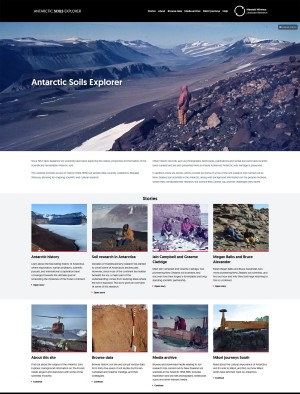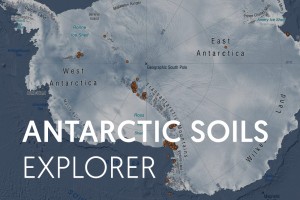Frozen assets: enabling access to New Zealand’s Antarctic soils heritage

Graeme Claridge admiring the spectacular Wright Valley, 1982 (Photo credit: Iain Campbell)
New Zealand was the starting point for many of the early Antarctic expeditions, and we have had a permanent presence in the Ross Sea region since 1957. We are also one of the original signatories of the Antarctic Treaty (1959). This means we have a responsibility to understand and care for the unique Antarctic habitats, including the famous McMurdo Dry Valleys.
Researching and protecting Antarctic environments – including Antarctic soils – is critically important to our understanding of the impact and potential mitigation of climate change. Since the 1990s scientific interest in Antarctic soils has grown, with the number of scientific, peer-reviewed journal articles on this topic doubling every decade. Despite this, improving our information base on the properties of Antarctic soils has been identified as a key challenge (Roudier et al. 2022). Our project has sought to address this by widening public knowledge of Antarctic soils, and improving access to Antarctic soil samples and data for scientific research.
Soil data from polar latitudes are rare, and our collection of Antarctic soil samples is truly unique. It provides the best record of Antarctic soils in their most pristine condition, with the earliest collected samples essentially representing pre-human visitation. These samples also predate the arrival of micro-plastics. Archived soils are invaluable ‘time capsules’ for assessing temporal changes in soil properties, particularly as new analytical techniques become available. As a result, the data relating to these soils represent an important baseline comparison for all further scientific analysis on Antarctic soils, and they are of huge value to climate change research.
In 2021 we were granted funding support from Lottery Environment and Heritage and Manaaki Whenua to ensure New Zealand’s Antarctic soils heritage is professionally protected, managed, and made accessible for future generations. The goal is to preserve and curate the samples, and to make the information on the soils, collection details, cultural context, and data from scientific analysis available as part of our Land Resource Information System (LRIS) knowledge hub, one of New Zealand’s nationally significant databases and collection’s.
Our objectives were to (i) fully integrate the physical soil samples into the National Soils Archive, (ii) digitise and migrate the soils data into a modern database, (iii) catalogue any original materials and photographs, and (iv) publish relevant information online through a purpose-built, intuitive, interactive web portal.
We are delighted to report that we were able to process 8,837 samples with a combined weight of 1,582 kg. These are now stored and preserved at the Manaaki Whenua – Landcare Research quarantine facilities. The samples date back to the 1950s, when they were collected by pioneering soil scientists Drs John McCraw (1925–2014), Graeme Claridge (1932–2021), and Iain Campbell (1935–).

Figure 4. Landing page of the Antarctic Soils Explorer
We have also been able to record interviews with some of the early soil explorers in Antarctica, and with active support from Iain Campbell have digitised much of their original materials, such as notebooks and photographs. We have combined the data with cultural information and are presenting it online on the recently launched Antarctic Soils Explorer.
This web portal features information on Antarctic history, Antarctic soil research over time, and the scientists involved, as well as Māori connections to Antarctica. Original materials and recollections from Antarctic excursions, such as slides, photographs, and field notes from the original soil sampling excursions by Graeme Claridge and Iain Campbell, can be explored. The locations from which soil samples have been gathered are identified in an interactive map of the Antarctic continent, which means the interactive website offers a platform from which the soils of Antarctica can be explored and enjoyed.






